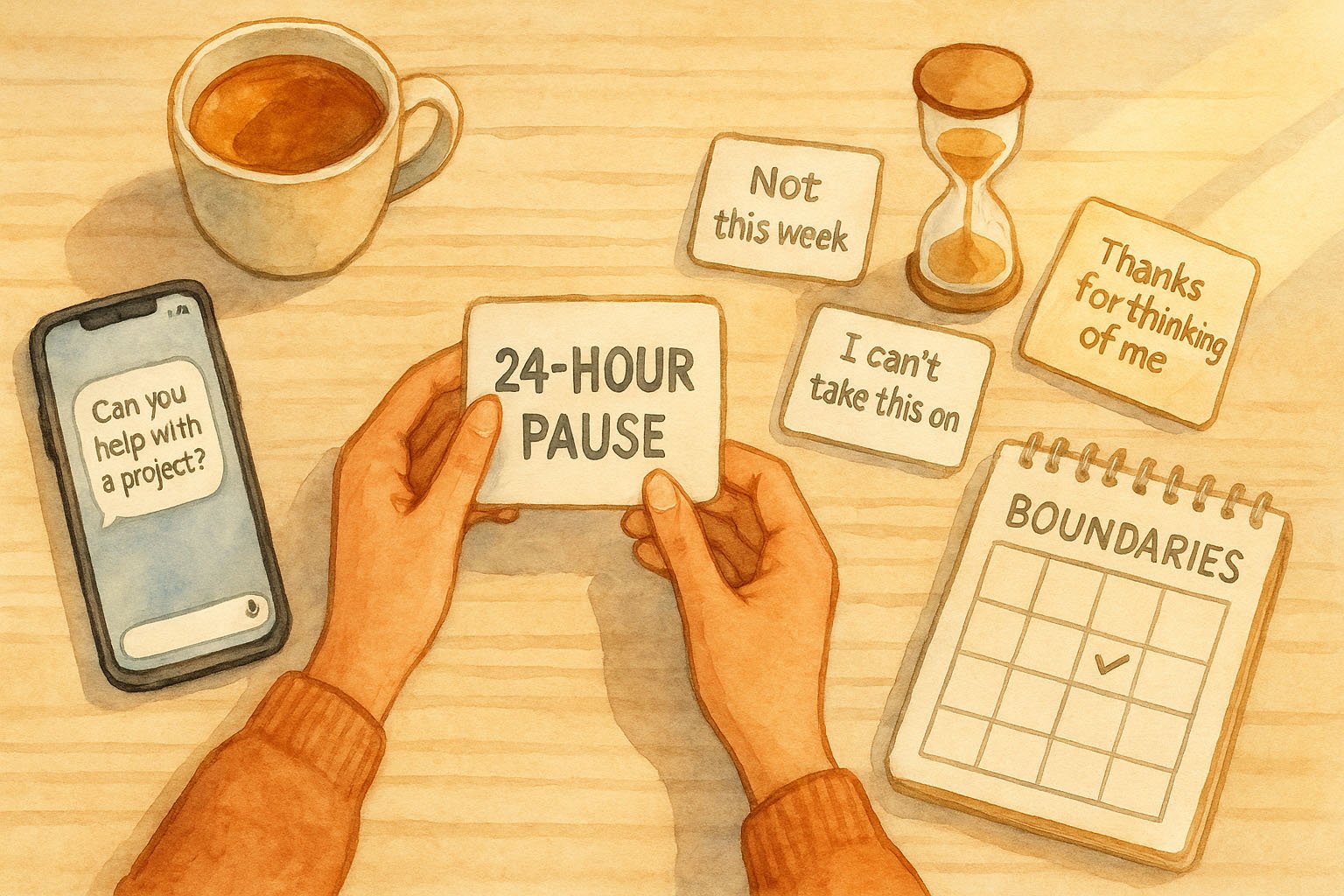Saying No Without Guilt: Changing the Pattern, Not the Person
Many people come to therapy wanting the perfect words for a difficult “no.” They imagine that if they could just find the right phrasing—something firm but not cold, kind but not self-sacrificing—the tension would ease. But the problem usually isn’t in the words themselves. It’s in the pattern that unfolds before the words ever arrive.
It’s a familiar cycle. Someone asks for your time or help. Your body tightens. You feel pressure in your chest or your jaw, and before you’ve had time to think, a “yes” slips out. Hours or days later, resentment appears. You wonder why you keep doing this—why you can’t seem to hold the line you promised yourself you would.
That reaction isn’t a flaw; it’s a learned survival strategy. Somewhere along the way, your nervous system equated agreement with safety. Saying yes or avoiding conflict kept you connected, approved of, or loved. Saying no felt risky or even dangerous. Over time, the habit becomes automatic, and you may often find yourself in relationships, both personal and professional, where demands are frequent and rest feels like a luxury.
The Inner Conflict Beneath the Boundary
When clients talk about boundaries, they often describe them as battles with other people—colleagues, parents, partners, friends. But the real struggle usually happens inside. One part of you wants peace, to smooth things over and maintain harmony. Another part longs for rest, honesty, and self-respect. Both are trying to help you feel safe.
When you can recognize this internal tug-of-war, something begins to shift. You start to see that it’s not about fixing yourself or convincing someone else to understand—it’s about interrupting a loop that no longer serves you. That small act of awareness changes the dynamic.
The other person isn’t the problem; the old pattern is. Once you see it clearly, you can begin to respond rather than react.
Finding Safety Before Finding Words
You can’t set healthy boundaries from a nervous system in alarm. When your body feels cornered, you’ll either rush to appease or swing toward defensiveness. The real skill lies in finding internal safety before trying to find the perfect words.
Sometimes that safety begins with the simplest permission: you don’t have to decide right now. You’re allowed to pause. In therapy, I often suggest people give themselves a 24-hour window before agreeing to anything that feels activating. This isn’t avoidance—it’s regulation. It’s what allows the thinking part of your brain to come back online after the stress response has already fired.
When you give yourself that breathing space, you can check in more honestly. What am I actually capable of right now? What do I truly want to offer? What would it feel like to answer from calm rather than from guilt?
The Practice of Saying No
From that grounded place, your “no” begins to sound different. It’s not defensive or apologetic—it’s simply clear. You might say, “I’d love to help, but I don’t have the bandwidth this week,” or “I want to say yes, but I’d end up stretched too thin.” Sometimes it’s as simple as, “I’d like to talk and offer support, but my plate is full right now, and I need to take care of my own mental health.”
The tone matters less than the truthfulness behind it. Boundaries don’t require long explanations. In fact, brevity often communicates respect. A single honest sentence, delivered with warmth, carries more integrity than five minutes of justification.
Still, guilt often follows. That’s normal. Guilt is just an echo of the old belief that protecting your own needs means you’re letting someone down. But guilt isn’t proof of wrongdoing—it’s evidence that you’re doing something new. When it appears, take a breath and remind yourself: I’m not rejecting anyone. I’m caring for my energy so I can show up well in the places that matter most.
The more you practice, the more your body learns that saying no is safe—that honesty and belonging can coexist.
Staying Warm and Firm
Sometimes people will still feel disappointed. That doesn’t mean you need to change your answer. You can hold compassion and clarity at the same time: “I hear that this matters to you—and I still can’t take it on.”
Over time, others begin to trust your no—and your yes. Real relationships deepen when both people can count on honesty instead of appeasement.
The Rhythm of Care
Learning to say no without guilt is really about learning to trust yourself. Each time you pause before reacting, you teach your body that it’s safe to have limits. Boundaries aren’t walls; they’re the structure that allows care—both for yourself and your relationships—to last.
If this is work you’re ready to explore, I offer individual and couples therapy in Manhattan, near Washington Square Park, focused on boundaries, burnout, and nervous system regulation. You’re welcome to reach out for a brief consultation.
Because when you stop apologizing for your limits, your “yes” begins to mean something again.




